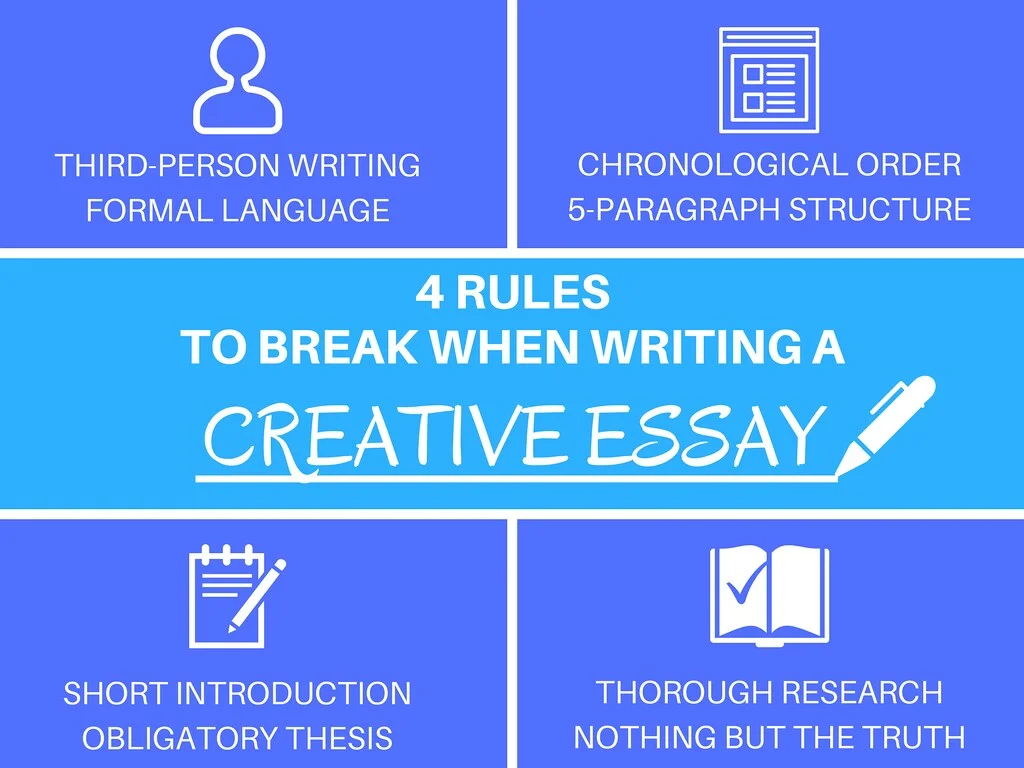
Things you need to know to craft a stunning creative essay
For years the teachers have been drilling you to write in the third person, follow the five-paragraph structure and research each topic to within an inch of its life. But now you have to write a creative essay, and if you adhere to the rules you’ve been taught, you will never get an A. Sure, getting essay writing assistance may be an optimal solution to boost your grades, but what if you want to craft your papers with no outside help? Consider the idea of hiring an essay writer as an extra option that is available at any time. At the same time, make maximum effort to cope with the project independently, without side assistance. So what is the trick to writing perfect creative essays? First, forget everything you know about academic writing rules! Now you are ready to embark on an exciting journey of writing a creative essay.
Where do you want to go with a creative essay?
Many students misunderstand the meaning of creative essays, confusing them with fictional writing. Creative essays are, in fact, a non-fiction genre. Autobiographies and memoirs are the prominent examples of creative nonfiction writing. While the professor does not expect to learn your life’s story, the essay should depict a significant event, person or object from your past.
Creative papers are a fusion of reflective, descriptive and narrative essays. You should share personal information, describe a significant person or event. Tell a compelling story that will grab the readers’ attention and keep them glued to your writing until the end. The creative part is the way to tell a story, embellishing it with metaphors and symbols. Use your favorite literary devices to turn the most boring of stories into an exciting tale.
Writing a creative essay is about breaking the rules
Writing a creative essay might seem impossible if you try to do it the same way as other academic assignments. If you are struggling with this paper, it’s time to forget everything you have learned about academic writing. You can forget about:
Rigid 5-paragraph structure and chronological order
Good stories do not fit the mold of a standard 5-paragraph essay, so you can happily ditch this outline. Instead, think in terms of a set-up, a confrontation, and a resolution. The creative essay introduction is about introducing the characters and setting up the action of the central part of the story. Confrontation takes up the largest portion of the essay and involves the growing tension and conflict. The confrontation always leads to a climax or a turning point after which the action winds down and the characters get a resolution.
The creative essay conclusion does not always have to be as neat and satisfying as in your other papers. You can create an open ending or finish with a cliffhanger.
While narrative and observation essays imply chronological order, creative papers provide you with rare artistic freedom. If you enjoy flashbacks, you can insert them into your story to make for more dynamic action. You can even stitch together a series of seemingly unrelated scenes to tie them all together in the resolution. Get creative, but make sure the readers will follow your story through all the unexpected twists and turns.
Short introduction and obligatory thesis statement
By now you know everything about writing paper introductions. They should be short, to the point and include both an attention-grabbing hook and a thought-provoking thesis. Writing a creative essay introduction, you can forget about these rules.
You sure need to grab the readers’ attention, but also introduce the main characters of the story, set up the premise and hint at the reasons for conflict. Don’t stretch the introduction, but don’t squeeze everything into three sentences. Your goal is to hook the readers emotionally, make them invested in the characters and the story so they don’t put the paper away until the end.
The truth, the whole truth, and nothing but the truth
While creative essays provide artistic freedom, most teachers expect to read a real story, not a fictional one. So before you pick a speculative topic, like “How many people will stay back on Earth in the age of space colonization?”, consult your professor.
Even if you have to write about an actual event that took place in the past, you don’t have to turn your creative essay into a witness testimony. You can omit the details that are not important to the narrative or add something to enhance the atmosphere of your story. This doesn’t mean to should lie or invent unrealistic details. Tell the truth, but be creative about it.
Formal language and third person writing
Most essays, except reflective papers, require third-person narration, formal language and objective analysis, but creative essay format calls for a personal tone. You get the chance to write in the first person and use the language you want. The more personal you get, the better. Explain the story through the lens of your perception, don’t sound objective and unbiased. Share strong emotional reactions, and your readers will share your joy or grief.
Metaphors, symbolism, and allegory are all fair play, as long you know how to use them. Extended metaphors that permeate the whole story and recurring symbols are particularly powerful. Think of an eagle in the “Assassin’s Creed”.
Writing a creative essay differs greatly from your run-of-the-mill academic assignments. You can ditch most of the rules the teachers have been drilling into you since you started school. Still, keep in mind what a creative essay is and how to make it stand out with the proper use of first-person writing, unconventional structure and attention-grabbing set up. Think before you use the artistic freedoms provided by the creative essay assignment, and you will get that A you crave.
In case you are not comfortable with creative writing after years of formal essays, don’t bend yourself out of shape. Let our writers deal with your assignment!




Comments (0)
Thank you for your comment! 🌟
It has been submitted and is awaiting moderation. Stay tuned—it will be visible soon!